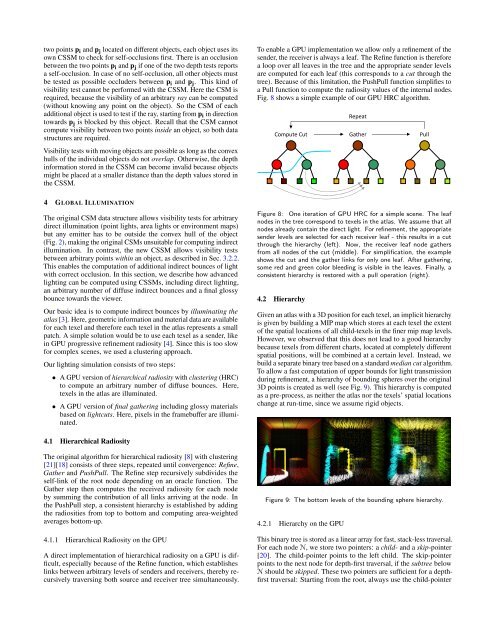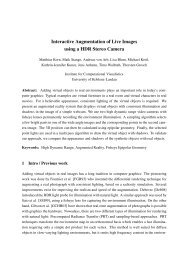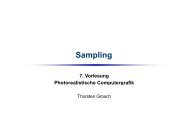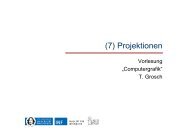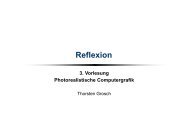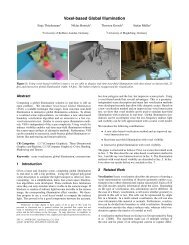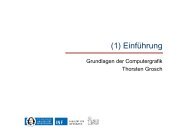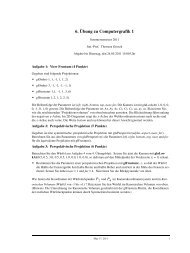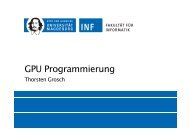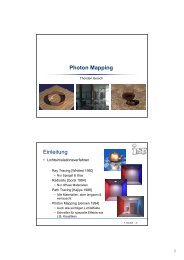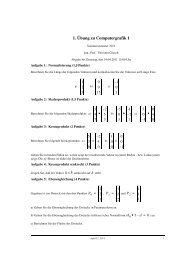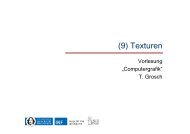Interactive Global Illumination Based on Coherent Surface Shadow ...
Interactive Global Illumination Based on Coherent Surface Shadow ...
Interactive Global Illumination Based on Coherent Surface Shadow ...
You also want an ePaper? Increase the reach of your titles
YUMPU automatically turns print PDFs into web optimized ePapers that Google loves.
two points p i and p j located <strong>on</strong> different objects, each object uses its<br />
own CSSM to check for self-occlusi<strong>on</strong>s first. There is an occlusi<strong>on</strong><br />
between the two points p i and p j if <strong>on</strong>e of the two depth tests reports<br />
a self-occlusi<strong>on</strong>. In case of no self-occlusi<strong>on</strong>, all other objects must<br />
be tested as possible occluders between p i and p j . This kind of<br />
visibility test cannot be performed with the CSSM. Here the CSM is<br />
required, because the visibility of an arbitrary ray can be computed<br />
(without knowing any point <strong>on</strong> the object). So the CSM of each<br />
additi<strong>on</strong>al object is used to test if the ray, starting from p i in directi<strong>on</strong><br />
towards p j is blocked by this object. Recall that the CSM cannot<br />
compute visibility between two points inside an object, so both data<br />
structures are required.<br />
Visibility tests with moving objects are possible as l<strong>on</strong>g as the c<strong>on</strong>vex<br />
hulls of the individual objects do not overlap. Otherwise, the depth<br />
informati<strong>on</strong> stored in the CSSM can become invalid because objects<br />
might be placed at a smaller distance than the depth values stored in<br />
the CSSM.<br />
To enable a GPU implementati<strong>on</strong> we allow <strong>on</strong>ly a refinement of the<br />
sender, the receiver is always a leaf. The Refine functi<strong>on</strong> is therefore<br />
a loop over all leaves in the tree and the appropriate sender levels<br />
are computed for each leaf (this corresp<strong>on</strong>ds to a cut through the<br />
tree). Because of this limitati<strong>on</strong>, the PushPull functi<strong>on</strong> simplifies to<br />
a Pull functi<strong>on</strong> to compute the radiosity values of the internal nodes.<br />
Fig. 8 shows a simple example of our GPU HRC algorithm.<br />
Repeat<br />
Compute Cut Gather Pull<br />
4 GLOBAL ILLUMINATION<br />
The original CSM data structure allows visibility tests for arbitrary<br />
direct illuminati<strong>on</strong> (point lights, area lights or envir<strong>on</strong>ment maps)<br />
but any emitter has to be outside the c<strong>on</strong>vex hull of the object<br />
(Fig. 2), making the original CSMs unsuitable for computing indirect<br />
illuminati<strong>on</strong>. In c<strong>on</strong>trast, the new CSSM allows visibility tests<br />
between arbitrary points within an object, as described in Sec. 3.2.2.<br />
This enables the computati<strong>on</strong> of additi<strong>on</strong>al indirect bounces of light<br />
with correct occlusi<strong>on</strong>. In this secti<strong>on</strong>, we describe how advanced<br />
lighting can be computed using CSSMs, including direct lighting,<br />
an arbitrary number of diffuse indirect bounces and a final glossy<br />
bounce towards the viewer.<br />
Our basic idea is to compute indirect bounces by illuminating the<br />
atlas [3]. Here, geometric informati<strong>on</strong> and material data are available<br />
for each texel and therefore each texel in the atlas represents a small<br />
patch. A simple soluti<strong>on</strong> would be to use each texel as a sender, like<br />
in GPU progressive refinement radiosity [4]. Since this is too slow<br />
for complex scenes, we used a clustering approach.<br />
Our lighting simulati<strong>on</strong> c<strong>on</strong>sists of two steps:<br />
• A GPU versi<strong>on</strong> of hierarchical radiosity with clustering (HRC)<br />
to compute an arbitrary number of diffuse bounces. Here,<br />
texels in the atlas are illuminated.<br />
• A GPU versi<strong>on</strong> of final gathering including glossy materials<br />
based <strong>on</strong> lightcuts. Here, pixels in the framebuffer are illuminated.<br />
Figure 8: One iterati<strong>on</strong> of GPU HRC for a simple scene. The leaf<br />
nodes in the tree corresp<strong>on</strong>d to texels in the atlas. We assume that all<br />
nodes already c<strong>on</strong>tain the direct light. For refinement, the appropriate<br />
sender levels are selected for each receiver leaf - this results in a cut<br />
through the hierarchy (left). Now, the receiver leaf node gathers<br />
from all nodes of the cut (middle). For simplificati<strong>on</strong>, the example<br />
shows the cut and the gather links for <strong>on</strong>ly <strong>on</strong>e leaf. After gathering,<br />
some red and green color bleeding is visible in the leaves. Finally, a<br />
c<strong>on</strong>sistent hierarchy is restored with a pull operati<strong>on</strong> (right).<br />
4.2 Hierarchy<br />
Given an atlas with a 3D positi<strong>on</strong> for each texel, an implicit hierarchy<br />
is given by building a MIP map which stores at each texel the extent<br />
of the spatial locati<strong>on</strong>s of all child-texels in the finer mip map levels.<br />
However, we observed that this does not lead to a good hierarchy<br />
because texels from different charts, located at completely different<br />
spatial positi<strong>on</strong>s, will be combined at a certain level. Instead, we<br />
build a separate binary tree based <strong>on</strong> a standard median cut algorithm.<br />
To allow a fast computati<strong>on</strong> of upper bounds for light transmissi<strong>on</strong><br />
during refinement, a hierarchy of bounding spheres over the original<br />
3D points is created as well (see Fig. 9). This hierarchy is computed<br />
as a pre-process, as neither the atlas nor the texels’ spatial locati<strong>on</strong>s<br />
change at run-time, since we assume rigid objects.<br />
4.1 Hierarchical Radiosity<br />
The original algorithm for hierarchical radiosity [8] with clustering<br />
[21][18] c<strong>on</strong>sists of three steps, repeated until c<strong>on</strong>vergence: Refine,<br />
Gather and PushPull. The Refine step recursively subdivides the<br />
self-link of the root node depending <strong>on</strong> an oracle functi<strong>on</strong>. The<br />
Gather step then computes the received radiosity for each node<br />
by summing the c<strong>on</strong>tributi<strong>on</strong> of all links arriving at the node. In<br />
the PushPull step, a c<strong>on</strong>sistent hierarchy is established by adding<br />
the radiosities from top to bottom and computing area-weighted<br />
averages bottom-up.<br />
4.1.1 Hierarchical Radiosity <strong>on</strong> the GPU<br />
A direct implementati<strong>on</strong> of hierarchical radiosity <strong>on</strong> a GPU is difficult,<br />
especially because of the Refine functi<strong>on</strong>, which establishes<br />
links between arbitrary levels of senders and receivers, thereby recursively<br />
traversing both source and receiver tree simultaneously.<br />
Figure 9: The bottom levels of the bounding sphere hierarchy.<br />
4.2.1 Hierarchy <strong>on</strong> the GPU<br />
This binary tree is stored as a linear array for fast, stack-less traversal.<br />
For each node N, we store two pointers: a child- and a skip-pointer<br />
[20]. The child-pointer points to the left child. The skip-pointer<br />
points to the next node for depth-first traversal, if the subtree below<br />
N should be skipped. These two pointers are sufficient for a depthfirst<br />
traversal: Starting from the root, always use the child-pointer


